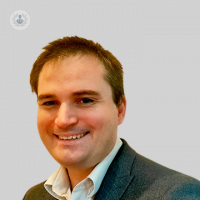Polymyositis
Dr Francis Kynaston-Pearson - Rheumatology
Created on: 11-13-2012
Updated on: 06-28-2023
Edited by: Aoife Maguire

What is polymyositis?
Polymyositis literally means many (“Poly”) muscles (“myo”) are inflamed (“itis”). This is a group of very rare rheumatic disease. These can be broadly divided into four main subtypes
- Polymyositis; involving mainly or only the muscles
- Dermatomyositis; usually involving muscles and giving a characteristic skin rash
- Juvenille Dermatomyositis; when affecting children (and usually carrying a better outlook)
- Inclusion body myositis; often presenting similarly but behaving differently to treatments
As the name suggests, the most common presentation is muscle pain. This most commonly affects a group of muscles that is closest to the body called “proximal” muscles, typically involving the shoulder and thigh areas.
Although it can occur at any age, it is most commonly diagnosed between the ages of 50 and 70 and is also more likely to occur in women than men.
Prognosis
It is important to know that polymyositis is rare and historically there was limited evidence and treatments for patients. As a result, patients may encounter alarming information about the outlook when researching online. Whilst there is no cure as yet, thanks to substantial advances in treatment and research, many patients with polymyositis respond positively to treatment and go back to leading full lives.
The condition can encompass a wide spectrum of presentations and in some cases, other organs are involved (particularly the lungs). In some adults, polymyositis may have arisen in response to an underlying cancer. Understanding the particular subtype of polymyositis you are suffering from (and any potential cause) is helpful in giving an idea on your likely prognosis.
Symptoms
The main symptoms are:
- Muscle pain, aches and weakness, especially first thing in the morning
- Struggling to lift your head due to neck muscle weakness
- Fatigue and tiredness when doing regular activities e.g. walking, sitting, lifting objects
- A rash affecting the hands, neck and face
- Raynaud’s disease (white discolouration of the fingers in cold weather)
- Shortness of breath or a dry cough
- Problems swallowing (dysphagia)
Medical tests to diagnose polymyositis
Your GP or private specialist will take your medical history (your symptoms, current medications etc.) and perform a physical examination. If you have a suspected case of polymyositis, you will likely require further tests:
- A blood test
- MRI (magnetic resonance imaging) scan
- A muscle biopsy and/or a skin biopsy
- Electromyography (EMG)
- Other imaging (such as a CT scan)
- Lung investigations if felt to be involved (such as a lung function test)
What are the causes?
The cause of polymyositis is unclear, but it may be caused by an autoimmune reaction or infected muscle.
Can it be prevented?
Unfortunately there is no known prevention for polymyositis. However, tending to your general health and avoiding possible triggers, such as smoking, is still worthwhile. If you suspect polymyositis, early diagnosis and intervention is key.
Treatments for polymyositis
Because polymyositis is very rare, there can be a delay in making a diagnosis. If the condition is suspected, it is vital to be referred for prompt assessment and investigation. Given the wide spectrum of disease, there is no “one-size-fits-all” approach. The following are likely to be considered:
Steroids
(Via tablet, injection or drip). These are used first line and are frequently very effective in getting on top of symptoms. Unfortunately high doses are often required which often leads to side effects and many patients will require additional drug therapies aimed at minimising the potential harms of steroids
Disease-modifying anti-rheumatic drugs
These are used to suppress the immune system. These can help take over from initial steroid therapy and include agents like azathioprine, methotrexate and mycophenolate.
Immunoglobulin therapy
Used in life threatening cases when needed to intervene in the attack by the immune system.
Biologic therapy such as Rituximab
Usually reserved when the condition is not responding to the above approaches or the polymyositis is also attacking organs like the lungs.
Physical therapy and exercise and an education programme
Used to show you how you can improve your muscle strength. Before starting an exercise or physiotherapy plan, you should discuss it with your specialist. Generally, specialists advise against exercising during severe flare-ups of symptoms.
Speech therapy
Provided if you have developed problems swallowing (dysphagia).
Which type of specialist treats polymyositis?
Rare conditions are best managed with a combination of different roles and sometimes from several different specialists. This “Multispecialty”, “multidisciplinary” approach will usually have a rheumatologist at the heart of it, coordinating your overall care. You may also need support from a respiratory clinician, dermatologist, rehabilitation consultant, physiotherapist, speech and language therapist, occupational therapist, dietician, clinical psychologist and more.


